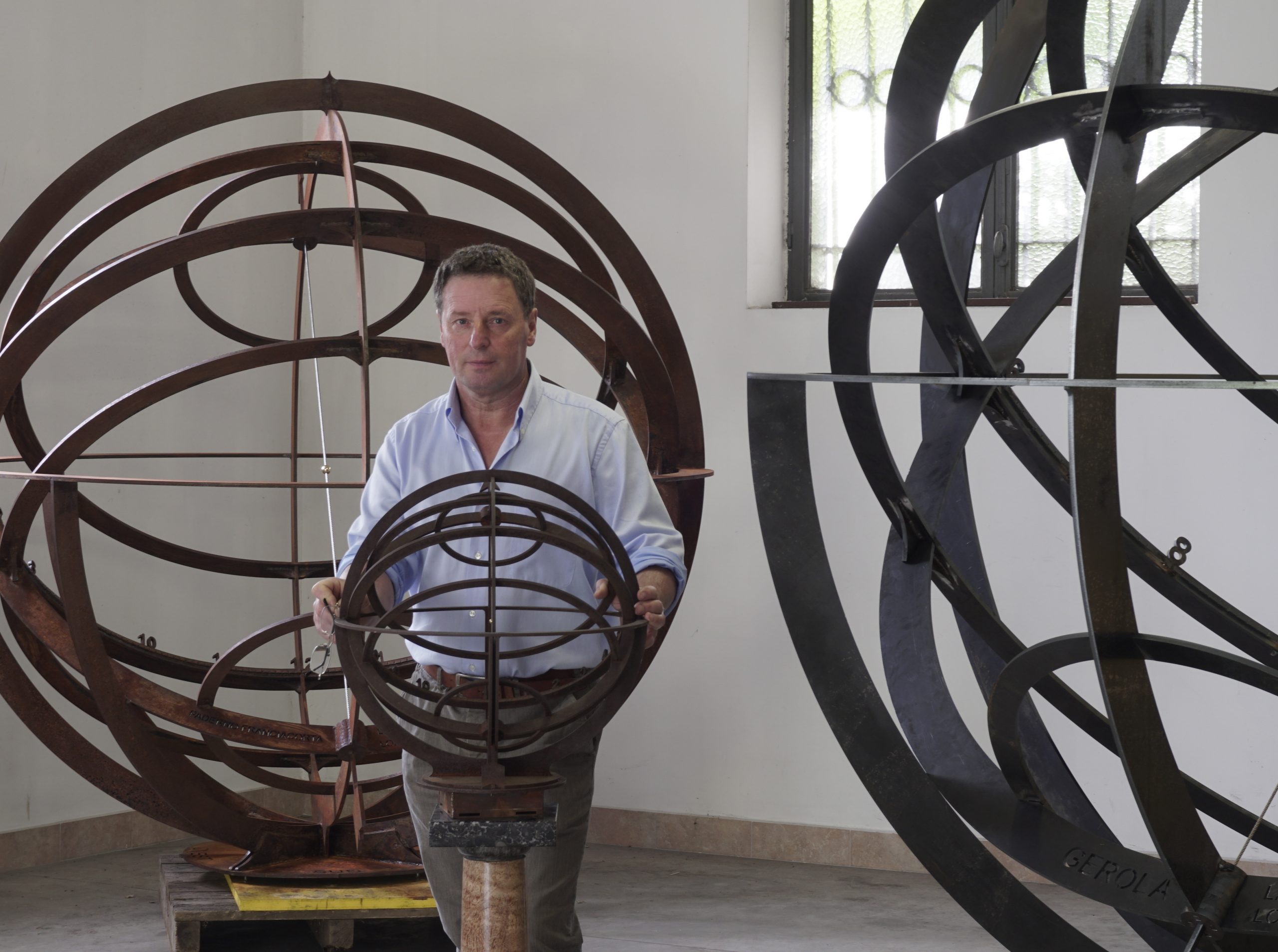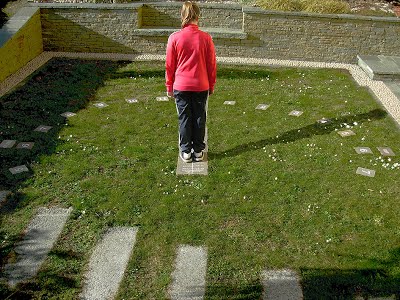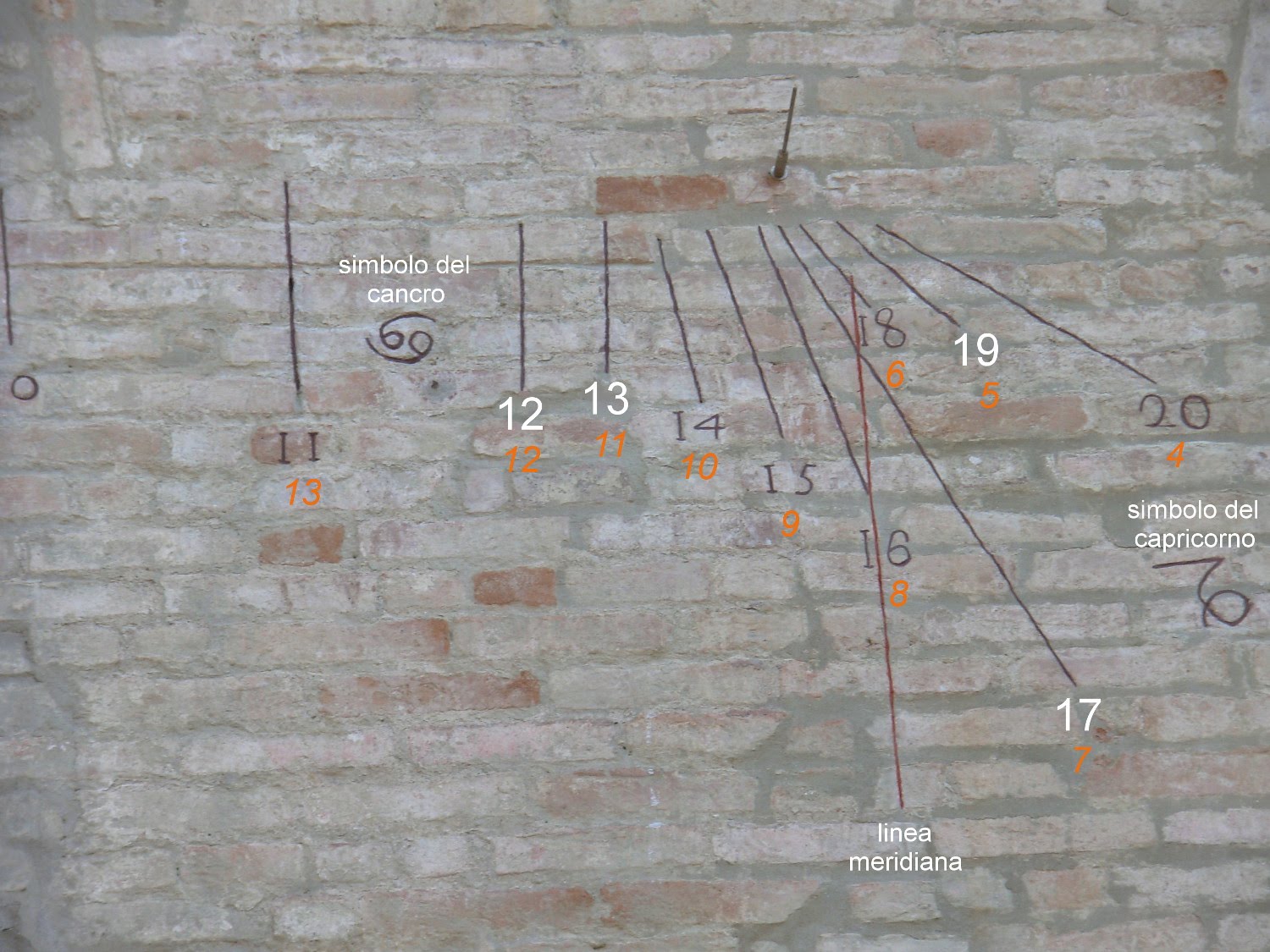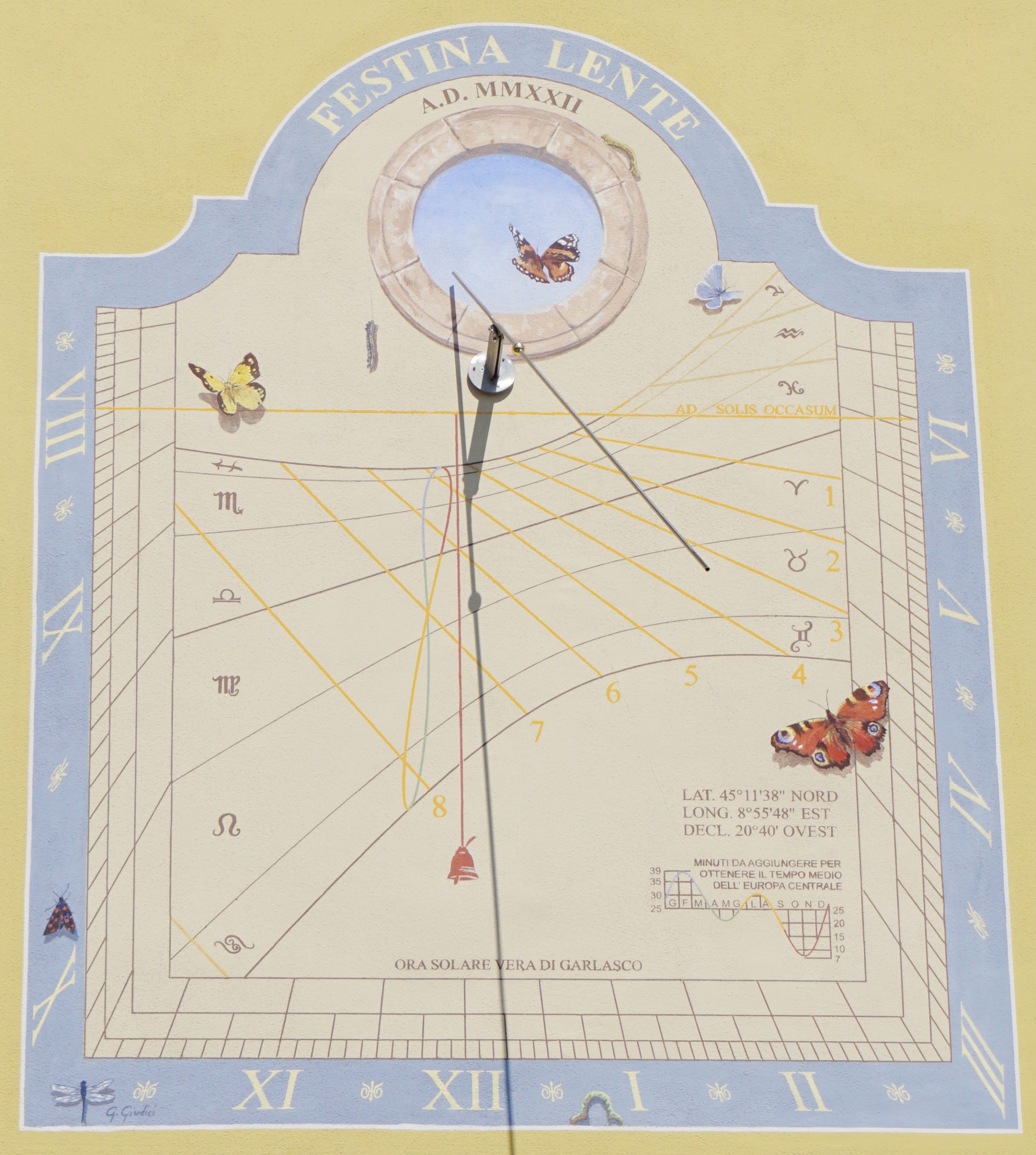
Sundial Garlasco
SUNDIAL
Garlasco Latitude 45°11’38” north
Longitude 8°55’48” east
Declination 20°40′ west (wall orientation)
Italic time system with remaining hours.
True local time. Meridian line.
Lemniscate for middle time Central Europe.
Astronomical calendar.
QUADRANT DESCRIPTION
The face of the sundial is decorated with caterpillars, butterflies and the simulation of a time-worn round window, which offers the possibility to see the sky beyond the wall, alluding to the fact that a sundial allows you to observe the sky in a unusual, as his diagrams are the mathematical projection of the celestial vault located in front of the instrument.
The face of the sundial is decorated with caterpillars, butterflies and the simulation of a time-worn round window, which offers the possibility to see the sky beyond the wall, alluding to the fact that a sundial allows you to observe the sky in a unusual, as his diagrams are the mathematical projection of the celestial vault located in front of the instrument.
The caterpillars and multicolored butterflies that enrich the decoration of the dial symbolize, in our Christian culture, earthly life in the caterpillar, which eats grass while crawling and life after resurrection in the butterfly that flies and sucks nectar; while in the iconography of many other cultures they represent the soul, rebirth and the cycle of transformation.
The motto “FESTINA LENTE”, “hurry slowly”, may seem like a mockery nowadays, in which frenzy is a lifestyle, but it is an apparent contradiction that on a sundial leads to multiple reflections .
Time is marked by means of the displacement of the shadow generated by the stainless steel rod, inclined so as to be parallel to the earth’s rotation axis and by the shadow produced by the golden sphere, which reproduces the apparent displacement of the sun in the sky .
The sundial diagram divides the celestial sphere into virtual celestial meridians and parallels, plotting them on the dial. The tracks are divided into two different time systems: italic and astronomical; a complete astronomical calendar and a lemniscate traced to indicate 12.00 when winter time is in effect, while it indicates 13.00 when summer time is in effect in our time zone.
ITALIC TIME SYSTEM WITH REMAINING HOURS
AD SOLIS OCCASUM

Yellow italic hour lines numbered with Arabic numerals
During the day, the movement of the shadow of the sphere on the inclined hour lines directly indicates how many hours of light there are still available before sunset.
The ancient Italic time system, in use in our peninsula from 1200 to 1800, was the most widespread in our territories and as per biblical tradition, it set the end of the day and the beginning of the following day at sunset, regardless of whether winter and summer, following day by day the instant of sunset along the arc of the seasons. This time system, which today may seem absurd, made it possible to know how many hours of light there were still available before dark, an information of enormous importance for the society of that time, practically still devoid of artificial light and which depended on the rhythms natural day and night.
The Italic time system that according to the Catholic tradition began to number the 24 hours starting from sunset onwards, until sunset of the following day, is taken up in this quadrant with the variant of the remaining hours, numbering backwards the hours left until sunset, as if it were a countdown of the hours until the sunset of our star.
MERIDIAN LINE

Vertical line drawn in red on which a bell hangs.
When the center of the sphere’s shadow touches the meridian line, it marks the passage of the sun over the local meridian of Garlasco.
The instant the center of the shadow of the sphere passes over the meridian line, the center of our planet, the red meridian line drawn on the wall, the golden sphere placed on the stylus and the sun all lie on the same plane. The same instant marks the true noon of Garlasco, which occurs several minutes later than the noon of our time zone, due to the difference in longitude that separates Garlasco from the reference meridian of our time zone and varies with the passing of days due to the elliptical orbit of the earth around the sun.
LEMNISCATA LINE
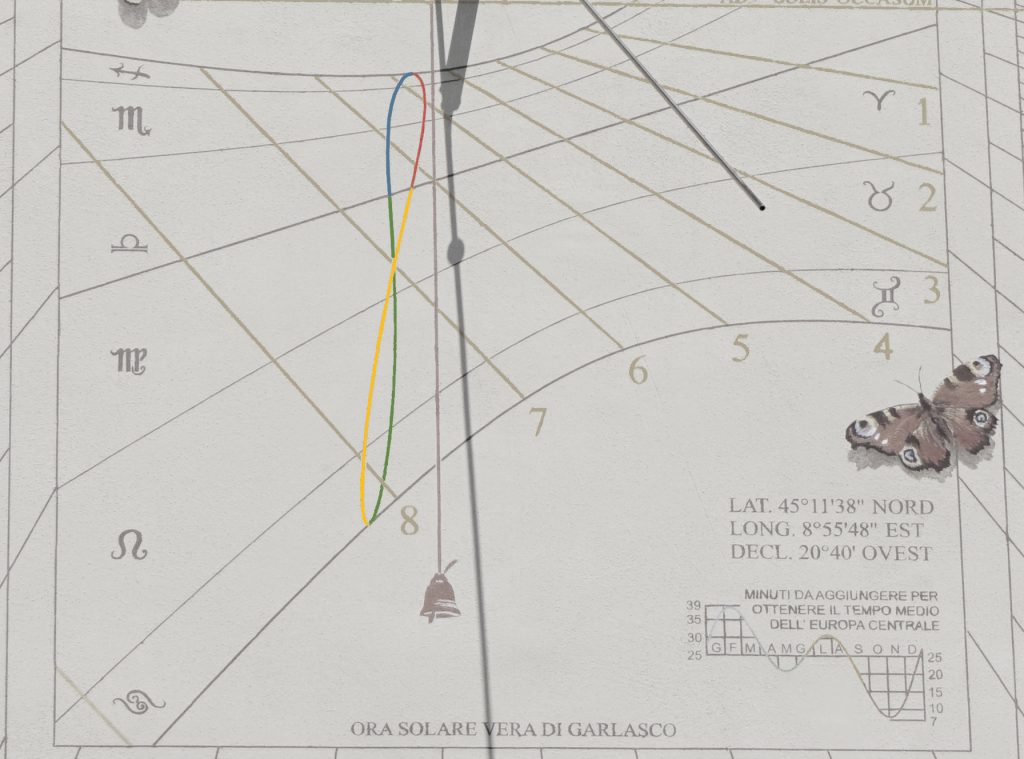
Curved line similar to an elongated eight painted in blue, green, yellow and red.
When the center of the shadow of the sphere passes over this line, it indicates 12.00 when winter time is in effect and 13.00 when summer time is in effect in our time zone, highlighting the advance of this instant during the span of the seasons with respect to the true local time. The blue line indicates midday in the winter months, the green line in the spring months (1.00pm with summer time), the yellow line in the summer months (1.00pm with summer time) and the red line in the autumn months, graphically representing the delay expressed in minutes by GRAPH A shown below and in a more synthetic way in the lower right corner of the dial directly on the dial.
TRUE LOCAL TIME
REAL SUN HOUR OF GARLASCO
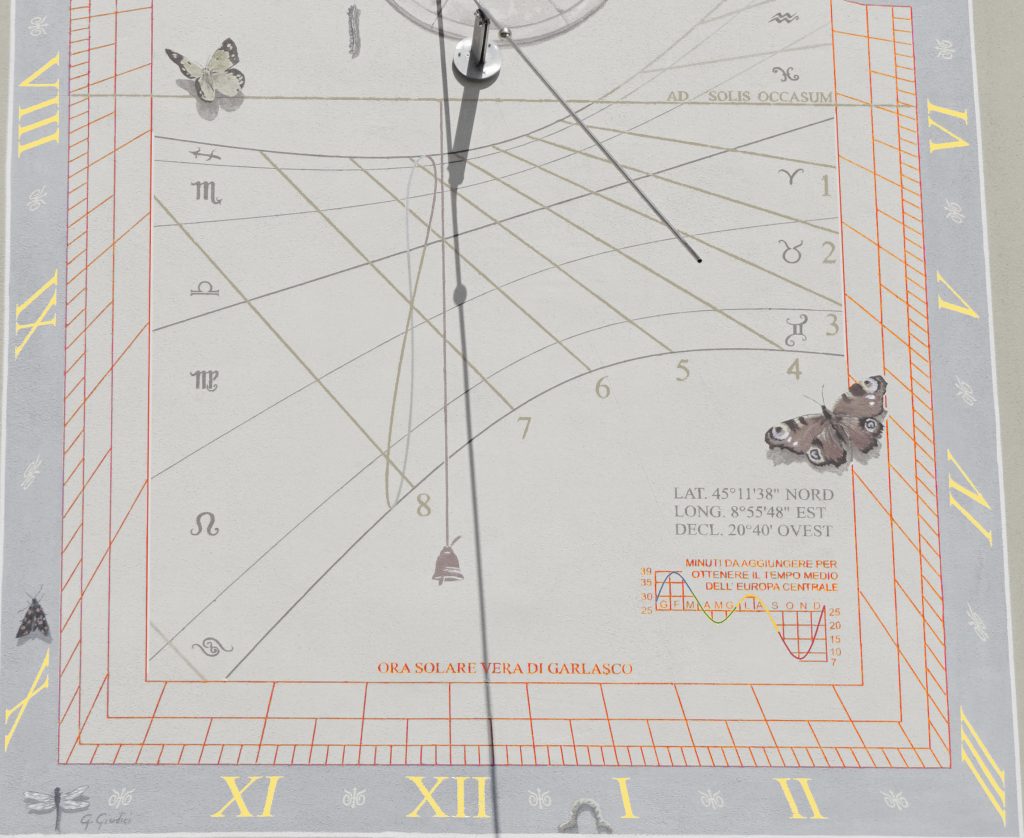
Astronomical hour lines, drawn with a step of 5 minutes only in their terminal part near the frame and numbered with Roman numerals on a blue background.
The scrolling of the shadow of the steel rod marks the true solar time of Garlasco, to which, according to the observation date, the minutes of the graph at the bottom right can be added, in order to obtain the time of our time zone (the average time in Central Europe), adding an extra hour when summer time is in effect in the summer.
DIFFERENCE BETWEEN TRUE LOCAL TIME AND THE
TIME INDICATED BY OUR TIME ZONE
Our time zone is nothing more than an arbitrarily set time, standardizing by convention the time of several nations in order to facilitate human activities, for example transport and telecommunications. Winter time is usually called solar time as it is the hour that comes closest to true solar time. The time that is marked in the time zone is the result of the sum of two distinct corrections: constant longitude correction and mean time correction.
Constant correction of longitude
The map below shows the longitude correction, highlighting the longitude distance between Garlasco and the 15th meridian East, the reference for our time zone. A distance in longitude of 6 ° 4’12 ” which turns into a constant year-round delay of 24 minutes and 17 seconds, then the sun rises, culminates at noon and sets in Garlasco 24 minutes and 17 seconds later than our reference meridian.
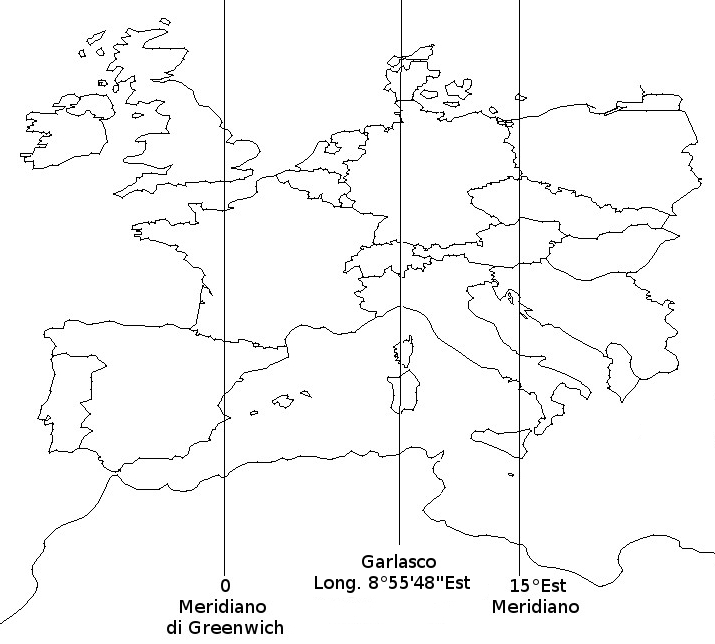
Average time correction
To be able to compare our mechanical watches with the sundial, we need to add or subtract from the delay due to longitude, the minutes due to the difference in the mean time, a difference caused mainly by the complex gravitational forces that affect the speed of rotation of the earth around the sun and from its elliptical orbit, which varies according to the seasons by about 14 minutes early and 16 minutes late.
Both differences are calculated in the following table: according to the observation date, by adding the minutes of the table to the true local time marked by the sundial, we obtain the average time of Central Europe, the time of our time zone, at which an extra hour must be added when summer time is in effect.

GRAPH A
To obtain the time of the time zone, add to the local solar time indicated by the shadow, the minutes of the left column marked in the table above, following the value shown in the graph by the magenta line, according to the observation date. Add an additional hour when summer time is in effect in the summer.
ASTRONOMIC CALENDAR AND ZODIAC SYMBOLS
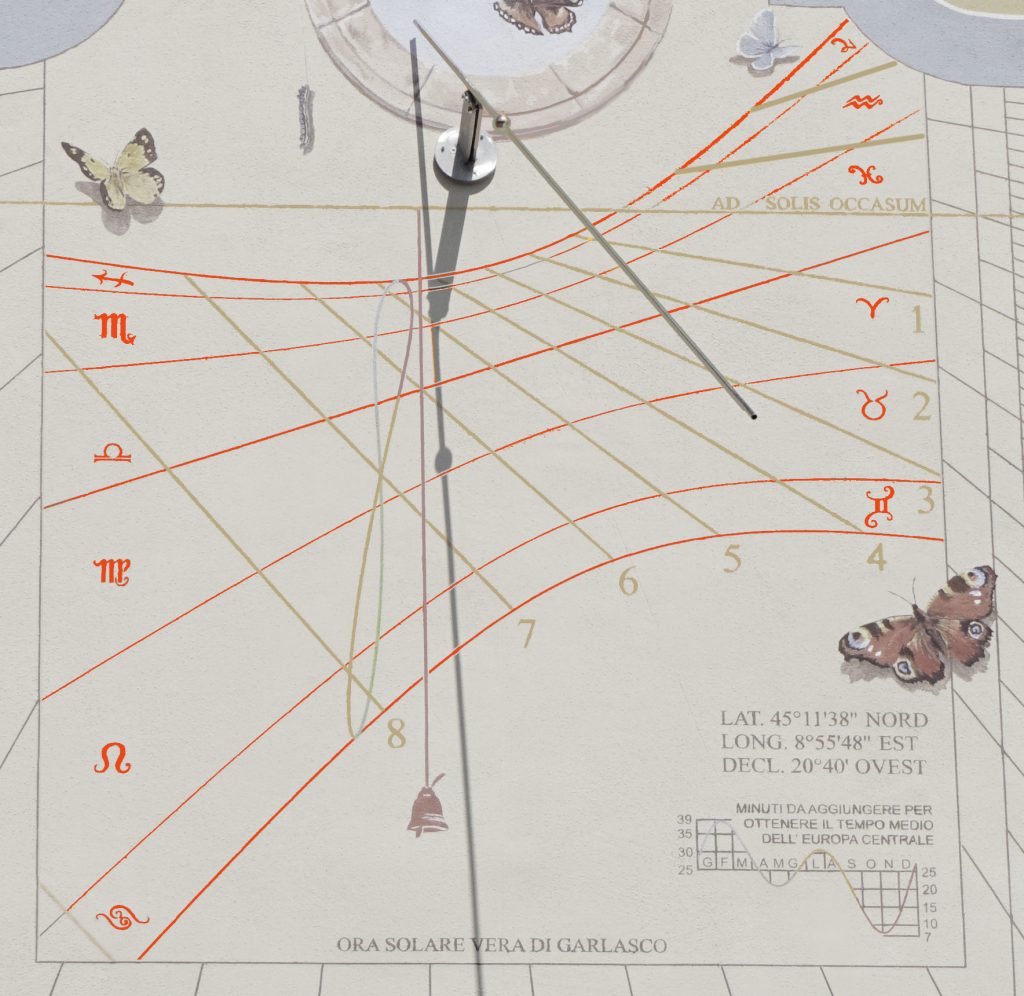
Curved lines and central straight line marked with zodiac symbols.
It is an astronomical calendar, marked by the change of the zodiac signs that occur on average on the 21st of each month: six signs, from the winter solstice to the summer solstice, when the sun rises more and more, making every day a ever higher and wider circle; six signs, from the peak of the summer solstice to the winter solstice, when the sun returns to lower each day more than the other, making an ever lower and shorter arc.

CAPRICORN
The shadow of the sphere runs through the band marked with this symbol usually from December 22nd winter solstice (upper hyperbola of the diagram) to January 20th. From December 22 onwards, the sun begins to rise again every day in the sky and the shadow of the sphere will return to descend again, retracing the other lines of the diagram in the opposite direction.

AQUARIUS
The shadow of the sphere runs along the band marked with this symbol usually from January 20 to February 19.

PISCES
The shadow of the sphere runs along the band marked with this symbol usually from February 19th to March 20th.

ARIES
The shadow of the sphere runs along the band marked with this symbol usually from the March 20 vernal equinox (the straight line in the center of the diagram) to April 20.

TAURUS
The shadow of the sphere runs along the band marked with this symbol usually from April 20 to May 21.

GEMINI
The shadow of the sphere runs along the band marked with this symbol usually from May 21st to June 21st summer solstice.

CANCER
The shadow of the sphere runs along the band marked with this symbol usually from June 21st summer solstice (lower hyperbola of the diagram) to July 23rd. From June 21 onwards, the sun begins to lower again every day in the sky and the shadow of the sphere will once again rise on the dial, retracing the other lines of the diagram backwards.

LEO
The shadow of the sphere runs along the band marked with this symbol usually from 23 July to 23 August.

VIRGO
The shadow of the sphere runs along the band marked with this symbol usually from 23 August to 23 September.

LIBRA
The shadow of the sphere runs along the band marked with this symbol usually from the September 23 autumn equinox (the straight line in the center of the diagram) to October 23.

SCORPIO
The shadow of the sphere runs along the band marked with this symbol usually from 23 October to 22 November.


